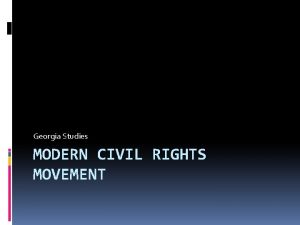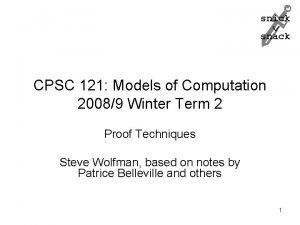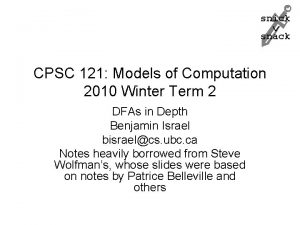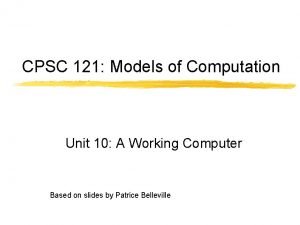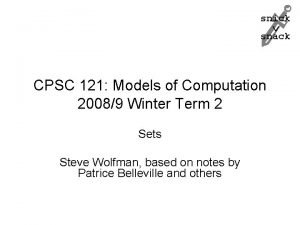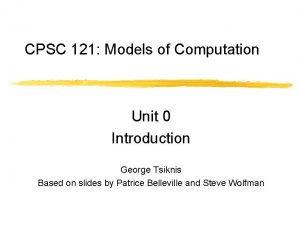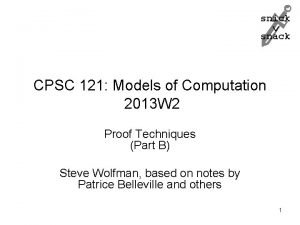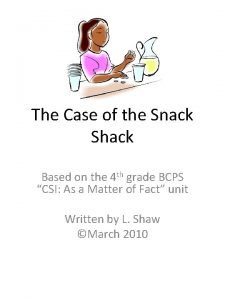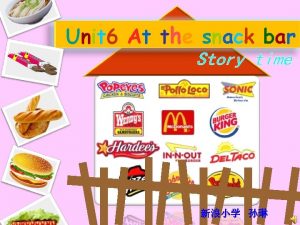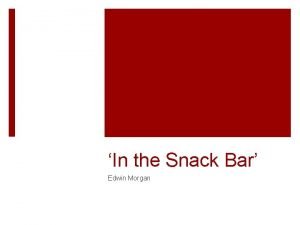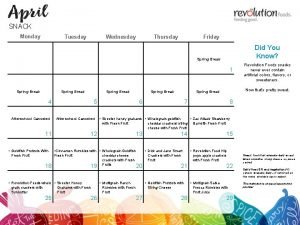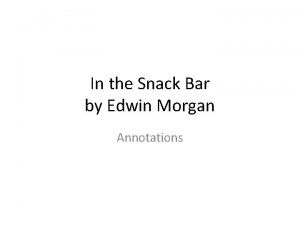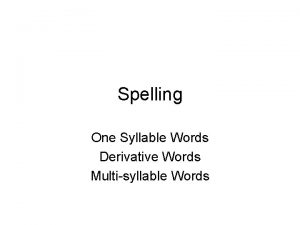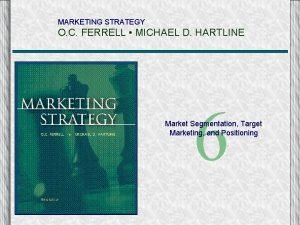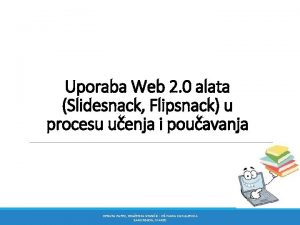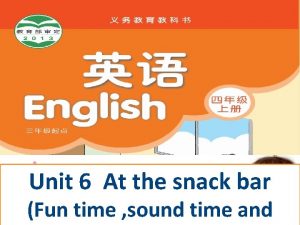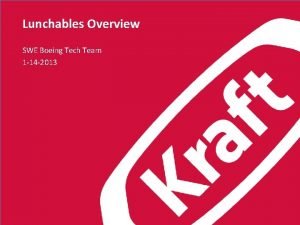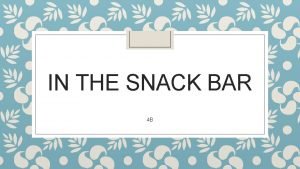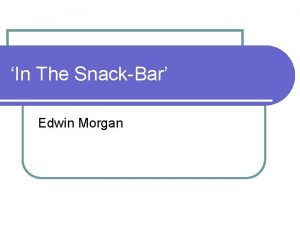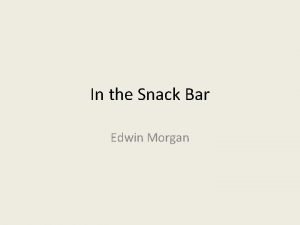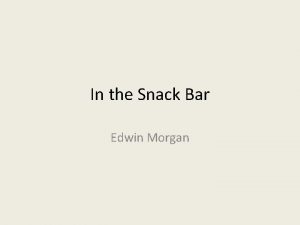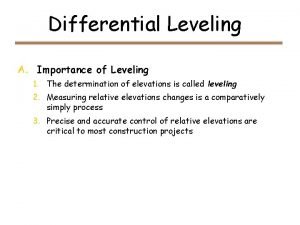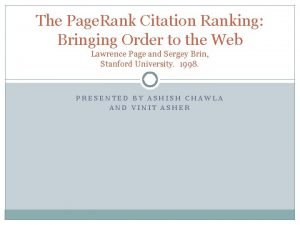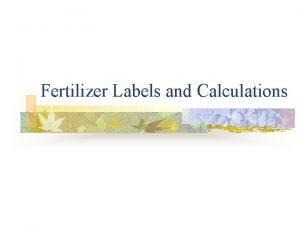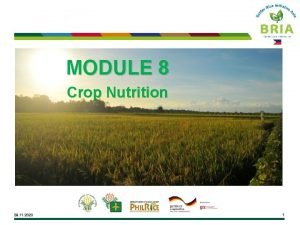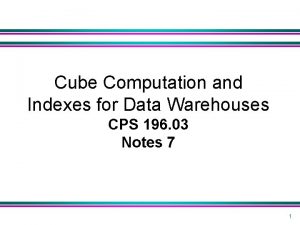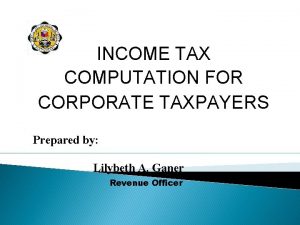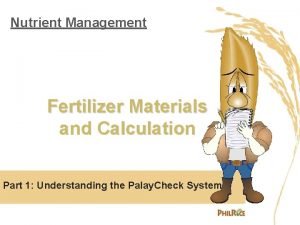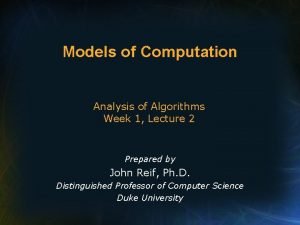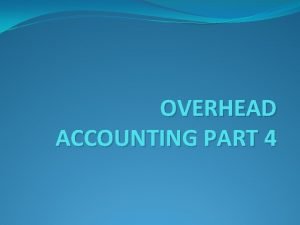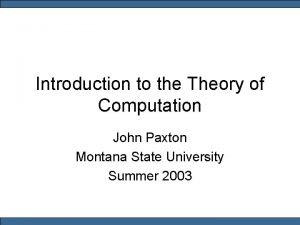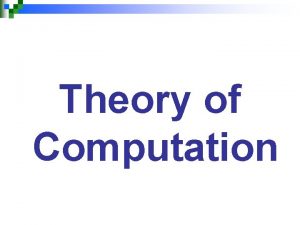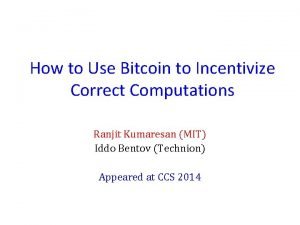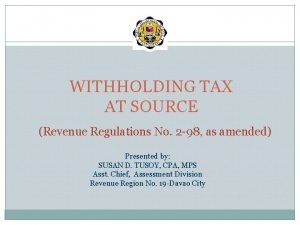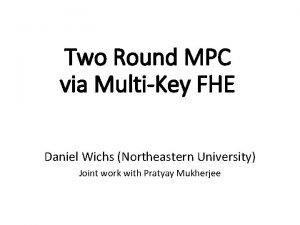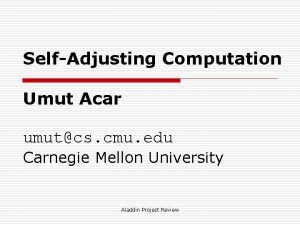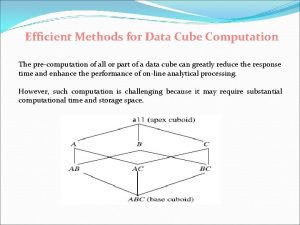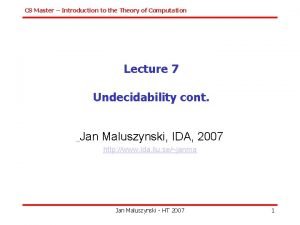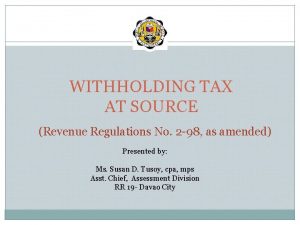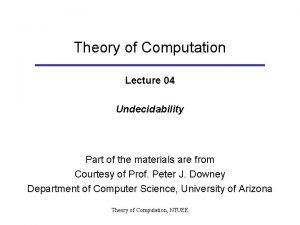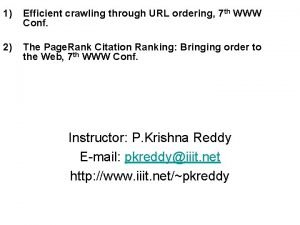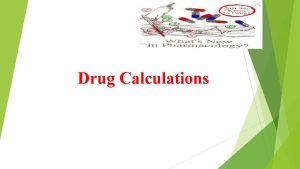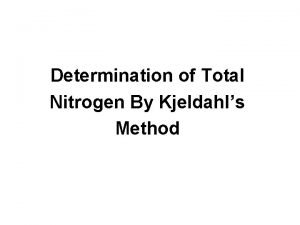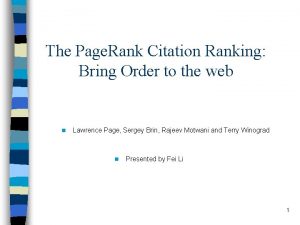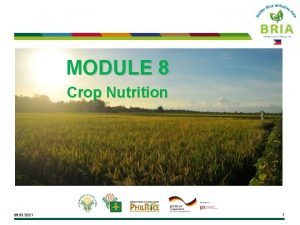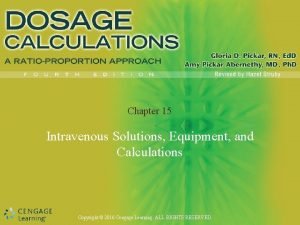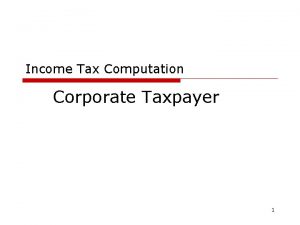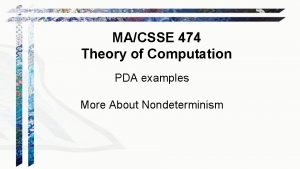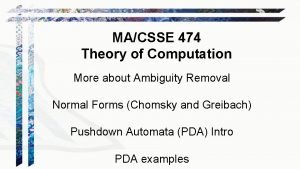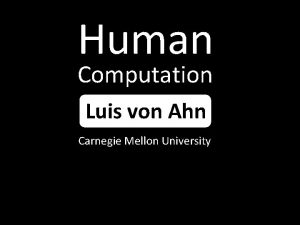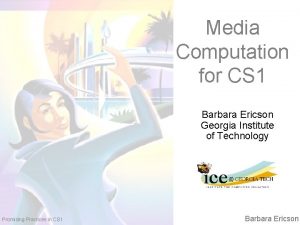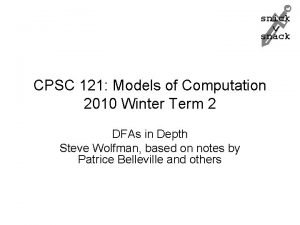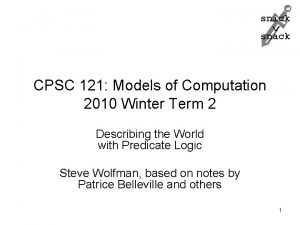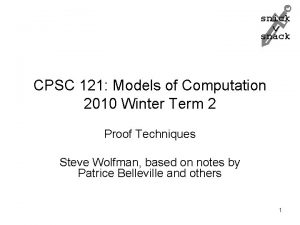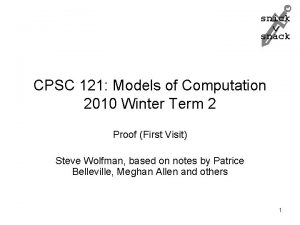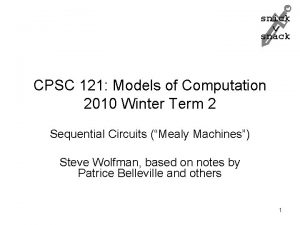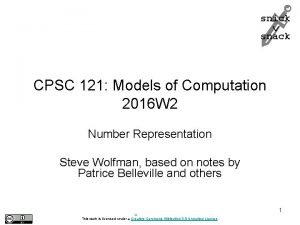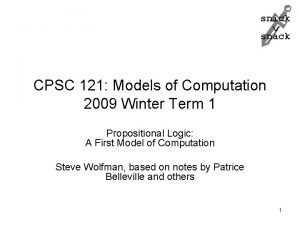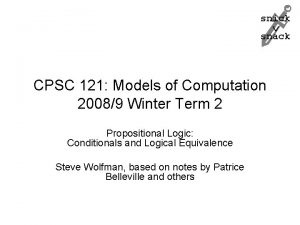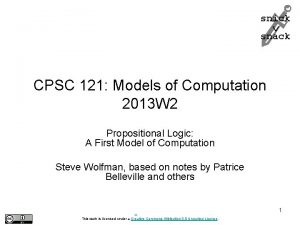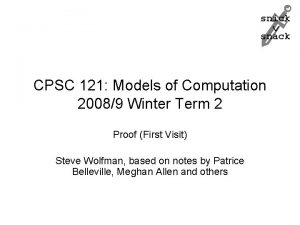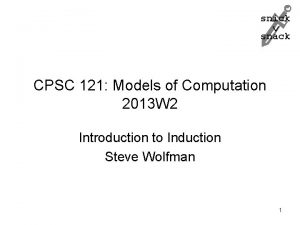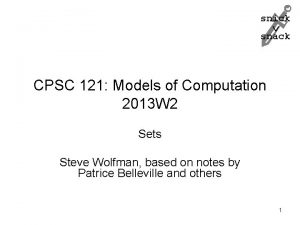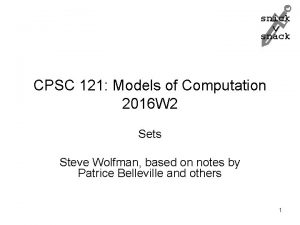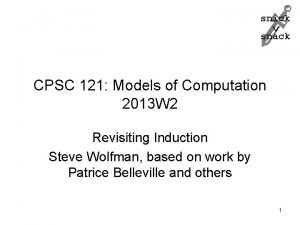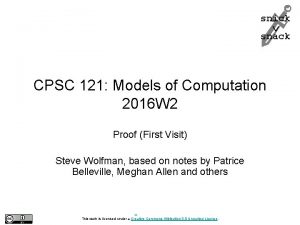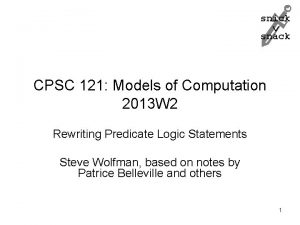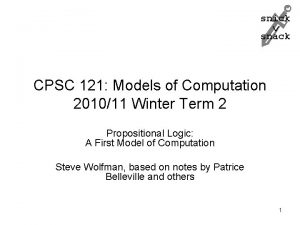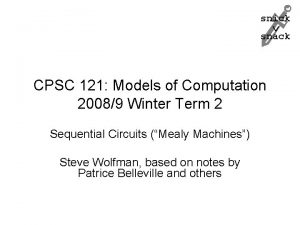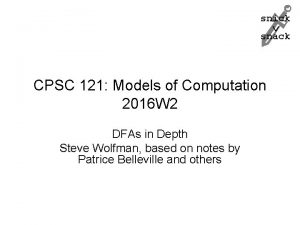snick snack CPSC 121 Models of Computation 2010























































- Slides: 55

snick snack CPSC 121: Models of Computation 2010 Winter Term 2 Number Representation Steve Wolfman, based on notes by Patrice Belleville and others 1

Outline • Prereqs, Learning Goals, and Quiz Notes • Prelude: “Additive Inverse” • Problems and Discussion – Clock Arithmetic and Two’s Complement – 1/3 Scottish and Fractions in Binary – Programs and Numbers – Programs as Numbers • Next Lecture Notes 2

Learning Goals: Pre-Class By the start of class, you should be able to: – Convert positive numbers from decimal to binary and back. – Convert positive numbers from hexadecimal to binary and back. – Take the two’s complement of a binary number. – Convert signed (either positive or negative) numbers to binary and back. – Add binary numbers. 3

Learning Goals: In-Class By the end of this unit, you should be able to: – Critique the choice of a digital representation scheme—including describing its strengths, weaknesses, and flaws (such as imprecise representation or overflow) —for a given type of data and purpose, such as (1) fixed-width binary numbers using a two’s complement scheme for signed integer arithmetic in computers or (2) hexadecimal for human inspection of raw binary data. 4

Where We Are in The Big Stories Theory Hardware How do we model computational systems? How do we build devices to compute? Now: showing that our logical models can connect smoothly to models of number systems. Now: enabling our hardware to work with data that’s more meaningful to humans. (And once we have numbers, we can represent pictures, words, sounds, and 5 everything else!)

Outline • Prereqs, Learning Goals, and Quiz Notes • Prelude: “Additive Inverse” • Problems and Discussion – Clock Arithmetic and Two’s Complement – 1/3 Scottish and Fractions in Binary – Programs and Numbers – Programs as Numbers • Next Lecture Notes 6

Prelude: Unsigned Integers We can choose any arrangement of Ts and Fs to represent numbers. . . But, we might as well choose something convenient. If we let F correspond to 0 and T to 1, then our representation is. . . # p q r 0 F F F 1 F F T 2 F T F 3 F T T 4 T F F 5 T F T 6 T T F 7 T T T 7

Prelude: Unsigned Integers. . . base 2 numbers. When we represent negative numbers, the choice is also arbitrary, but may as well be convenient: • Just one representation for zero • Easy to tell negative from positive (or nonnegative? ) • Basic operations easy. # p q r 0 0 1 2 0 1 0 3 0 1 1 4 1 0 0 5 1 0 1 6 1 1 0 7 1 1 1 But. . . What does it mean for basic operations to be “easy”? 8

Prelude: Additive Inverse The “additive inverse” of a number x is another number y such that x + y = 0. What is the additive inverse of 3? What is the additive inverse of -7? We want to be able to add signed binary numbers. We need 9 x + -x to be 0. And, we want addition to be easy to implement.

Outline • Prereqs, Learning Goals, and Quiz Notes • Prelude: “Additive Inverse” • Problems and Discussion – Clock Arithmetic and Two’s Complement – 1/3 Scottish and Fractions in Binary – Programs and Numbers – Programs as Numbers • Next Lecture Notes 14

Problem: Clock Arithmetic Problem: It’s 0500 h. How many hours until midnight? Give an algorithm that requires a 24 -hour clock, a level, and no arithmetic. A level is a carpentry tool, essentially a straightedge that indicates when it is either horizontal or vertical. 15

Clock Arithmetic 0500 is five hours from midnight. 1900 is five hours to midnight. 5 and 19 are “additive inverses” in clock arithmetic: 5 + 19 = 0. So are any other numbers that are “across the clock” from each other. That’s even true for 12. Its additive inverse is itself! 16

Clock Arithmetic Problem It’s 18 hundred. Without using numbers larger than 24 in your calculations, what time will it be 22*7 hours from now? (Don’t multiply 22 by 7!) a. 0 hundred (midnight) b. 4 hundred c. 8 hundred d. 14 hundred (Clock arithmetic is also known as 17 e. None of these modular arithmetic in mathematics. )

Clock Arithmetic: Food for Thought If we wanted negative numbers on the clock, we’d probably put them “across the clock” from the positives. After all, if 3 + 21 is already 0, why not put -3 where 21 usually goes? 0 -3 -6 -9 -12 18

Unsigned Binary Clock 000 111 001 110 Here’s a 3 -bit unsigned binary clock, numbered from 0 (000) to 7 (111). 010 101 011 100 19

Crossing the Clock 000 111 001 110 010 101 011 100 To “cross the clock”, go as many ticks left from the top as you previously went right from the top. Here’s a clock labelled with 0 (000) to 3 (011) and -1 (111) to -4 (100). 20

Reminder: Two’s Complement Taking two’s complement of B = b 1 b 2 b 3. . . bn: 1 1 1. . . 1 - b 1 b 2 b 3. . . bn -----x 1 x 2 x 3. . . xn Add 1 one + -----B Flip the bits 21

A Different View of Two’s Complement Taking two’s complement of B = b 1 b 2 b 3. . . bn: 1 1 1. . . 1 - b 1 b 2 b 3. . . bn -----x 1 x 2 x 3. . . xn Add 1 one + -----B Flip the bits 1 1 1. . . 1 + 1 -----1 0 0 0. . . 0 - b 1 b 2 b 3. . . bn -----B Or. . . Just subtract from 100. . . 0 22

Two’s Complement vs. Crossing the Clock Two’s complement with k bits: 1 1 1. . . 1 + 1 -----1 0 0 0. . . 0 - b 1 b 2 b 3. . . bn -----B “Crossing the clock” with k bits: 111 000 110 101 010 100 011 Equivalent to subtracting from 100. . . 000 with k 0 s. Two’s complement turns numbers into their 23 “normal”, “cross-the-clock” additive inverses.

Problem: Why Two’s complement? Why make the negation of 010 be 110? a. 010 + 110 already equals 0. b. 010 + 110 equals 1000. 000 111 c. 110 is the easiest negation to calculate. 110 d. 110 isn’t being used for any other purpose. 101 e. If you invert the bits in 100 110 and add 1, you get 010. 001 010 011 24

Summary Questions (1 of 2) • With n bits, how many distinct values can we represent? • What’s the smallest/largest n-bit unsigned binary integer? • What’s the smallest/largest n-bit signed (using two’s complement) binary integer? • Why the “extra” negative number? • How many representations for each number do we have with unsigned/signed binary integers? 25

Summary Questions (2 of 2) • How do we tell if an unsigned binary integer is: negative, positive, zero? • How do we tell if a signed binary integer is: negative, positive, zero? • How do we negate a signed binary integer? • What one value does that negation fail (or at least do something weird) on for signed binary integers? • How do we calculate the decimal value of a positive signed binary integer? • How do we calculate the decimal value of a negative signed binary integer? 26

Outline • Prereqs, Learning Goals, and Quiz Notes • Prelude: “Additive Inverse” • Problems and Discussion – Clock Arithmetic and Two’s Complement – 1/3 Scottish and Fractions in Binary – Programs and Numbers – Programs as Numbers • Next Lecture Notes 27

Problem: 1/3 Scottish Problem: Can you be 1/3 Scottish? 28

Problem: 1/3 Scottish Problem: Can you be 1/3 Scottish? To build a model, we must clearly specify the problem. Many problems admit multiple models that lead to fundamentally different results. We’re going to use the model of parentage “endowing” 50% of each parent’s “ishness”. That’s a coarse, even silly model. (By that model, none of us are Canadian, since humans did not originate in Canada. ) Our model is handy for us, but it’s not necessarily what people’s identity is about! 29

Can you be one-third Scottish? Focus on Mom (and Mom’s Mom and so on). We’ll just make Dad “Scot” or “Not” as needed at each step. Mom: ? ? Dad: ? ?

Can you be one-third Scottish? Mom: ? ? Dad: ? ? Mom: 2/3 Dad: Not

Can you be one-third Scottish? Mom: ? ? Dad: ? ? Mom: 1/3 Dad: Scot Mom: 2/3 Dad: Not

And so on. . . Mom: 1/3 Can you be one-third Scottish? Dad: Scot Dad: Not Mom: 2/3 Mom: 1/3 Dad: Scot What’s happening here? Mom: 2/3 Dad: Not

Dad: Scot Mom: 2/3 Dad: Not Mom: 1/3 Dad: Scot Mom: 2/3 Dad: Not 0. 0 1. . Mom: 1/3 Now, focus on Dad. . . We can represent fractions in binary by making “Scottish family trees”:

Mom: 0. 0 Dad: Scot Mom: 0. 5 Dad: Scot Mom: 0. 75 Dad: Not 0. 0 1 1 Here’s 0. 375 in binary. . .

Problem: 1/3 Scottish Which of the following numbers can be precisely represented with a finite number of digits/bits using a “decimal point”-style representation in base 10 but not base 2? a. 1/9 b. 1/8 c. 1/7 d. 1/6 e. None of these. 36

So. . . Computers Can’t Represent 1/3? No! Using a different scheme (e. g. , a rational number with a separate integer numerator and denominator), computers can perfectly represent 1/3! The point is: Representations that use a finite number of bits (all of them) have weaknesses. Know those weaknesses and their impact on your computations! 37

Outline • Prereqs, Learning Goals, and Quiz Notes • Prelude: “Additive Inverse” • Problems and Discussion – Clock Arithmetic and Two’s Complement – 1/3 Scottish and Fractions in Binary – Programs and Numbers – Programs as Numbers • Next Lecture Notes 38

What Doesn’t Work is Not Always Obvious (1 of 2) Class Main { public static void main(String[] args) { // Let's add up 4 quarters. System. out. println("4 quarters gives us: "); System. out. println(0. 25 + 0. 25); // Let's do something a hundred times. int i = 100; do { // Make i one smaller. i--; } while (i > 0); System. out. println("Done!"); System. out. println("i ended up with the value: " + i); System. out. println("It went down by: " + (100 - i)); } } 39

What Doesn’t Work is Not Always Obvious (2 of 2) Class Main { public static void main(String[] args) { // Let's add up 10 dimes. System. out. println("10 dimes gives us: "); System. out. println(0. 1 + 0. 1); // Let's try do something a hundred times. . // but accidentally go forever int i = 100; do { // Make i one LARGER. Oops! i++; } while (i > 0); System. out. println("Done!"); System. out. println("i ended up with the value: " + i); System. out. println("It went down by: " + (100 - i)); } } 40

Number Representation Prediction // Let's add up 10 dimes. System. out. println("10 dimes gives us: "); System. out. println(0. 1 + 0. 1); // Let's try do something a hundred times. . // but accidentally go forever int i = 100; do { // Make i one LARGER. Oops! i++; } while (i > 0); What will this print? a. First 1. 0 and then nothing because it runs forever. b. First 1. 0 and then some other value, because it won’t run forever. c. First something OTHER than 1. 0 and then nothing because it runs forever. d. First something OTHER than 1. 0 and then some other value, because it won’t forever. 41 e. None of these

Outline • Prereqs, Learning Goals, and Quiz Notes • Prelude: “Additive Inverse” • Problems and Discussion – Clock Arithmetic and Two’s Complement – 1/3 Scottish and Fractions in Binary – Programs and Numbers – Programs as Numbers • Next Lecture Notes 42

Preface: Java Byte Code Java programs are compiled to a language called “byte code” that is then interpreted on a particular computer. Why? Byte code is hard for humans to write, read, and understand. . . but it’s easy to write a program that reads and executes it (compared to writing a program to directly read and execute Java source code). So, if you create a brand new type of computer tomorrow, and I want to run my Java code on it, I don’t have to write a program that works on your computer and knows how to execute Java; I just need to write a program that knows how to execute byte code. Java byte code is also designed to be compact so it’s cheap to transmit across the internet.

Problem: Java Byte Code Problem: When compiled to bytecode, i = 100 might be “push 100; store in variable 1”. The “opcode” for bipush (push a byte) is 1610. The opcode for istore_1 is 6010. Here’s a typical “hex” view of ~1/5 th of the previous program’s byte code. Where is i = 100? a b b d c e: None of these. 44

Problem: Binary Byte Code Why would the same task (finding a particular snippet of code in a bytecode file) be much more difficult if the file were represented in binary? a. Because we would have to translate all the opcodes and values to binary. b. Because many bytecode files would have no binary representation. c. Because the binary representation of the file would be much longer. d. Because data like 1100100 (100 in base 2) might not show up as the sequence of numbers 1 1 0 0. e. It wouldn’t be much more difficult. 45

Problem: Decimal Byte Code Why would the same task (finding a particular snippet of code in a bytecode file) be much more difficult if the file were represented in decimal? a. Because we would have to translate all the opcodes and values to decimal. b. Because many bytecode files would have no decimal representation. c. Because the decimal representation of the file would be much longer. d. Because data like 100 might not show up as the sequence of numbers 1 0 0. e. It wouldn’t be much more difficult. 46

Outline • Prereqs, Learning Goals, and Quiz Notes • Prelude: “Additive Inverse” • Problems and Discussion – Clock Arithmetic and Two’s Complement – 1/3 Scottish and Fractions in Binary – Programs and Numbers – Programs as Numbers • Next Lecture Notes 47

Learning Goals: In-Class By the end of this unit, you should be able to: – Critique the choice of a digital representation scheme—including describing its strengths, weaknesses, and flaws (such as imprecise representation or overflow) —for a given type of data and purpose, such as (1) fixed-width binary numbers using a two’s complement scheme for signed integer arithmetic in computers or (2) hexadecimal for human inspection of raw binary data. 48

Next Lecture Learning Goals: Pre-Class By the start of class, you should be able to: – Use truth tables to establish or refute the validity of a rule of inference. – Given a rule of inference and propositional logic statements that correspond to the rule’s premises, apply the rule to infer a new statement implied by the original statements. 49

Next Lecture Prerequisites Read Section 1. 3 (Epp 3 rd ed) or 2. 3 (Epp 4 th ed). Complete the open-book, untimed quiz on Vista that is due before next class. 50

snick snack Some Things to Try. . . (on your own if you have time, not required) 51

Problem: Weighty Numbers Problem: You have a balance scale and four weights. You may choose the mass of the weights, as long as they’re in whole units of grams. What’s the largest number n such that you can exactly measure every weight 0…n? ? g ? g 52

Problem: Representing Data Problem: Devise two different ways to represent each of the following with bits: • black-and-white images • text • the shape of your face 53

Representing Characters 54

Problem: 256 -hour Clock Arithmetic Problem: Imagine you’ve built a computer that uses 256 -hour clock faces, each with a single dial, as storage units. How would you store, add, subtract, and negate integers? 55

Concept Q: 256 -hour Clock Arithmetic Java has a type called “byte” that is an 8 -bit signed integer. What will the following code print? byte b = 70; b = b + 64; a. A positive number, greater than 70. b. 70. c. A positive number, less than 70. d. 0. e. A negative number. 56

Problem: Number Rep Breakdown Problem: Explain what’s happening in each of these… 57

Program for Introductions: Testing Java version with 100: 9900 Java version with 8675309: 265642364 Java version with 1526097757: -645820308 Reminder: this is to calculate n*(n-1), the number of 58 introductions for a group of size n.

Program for Introductions: Testing Racket version with 100: 9900 Racket version with 8675309: 75260977570172 Racket version with 1526097757: 2328974362394333292 Reminder: this is to calculate (* n (- n 1)), the 59 number of introductions for a group of size n.
 Snick
Snick Cpsc 121
Cpsc 121 Cpsc 121
Cpsc 121 Cpsc 121 ubc
Cpsc 121 ubc Cpsc 121
Cpsc 121 Cpsc 121
Cpsc 121 Ubc cpsc 121
Ubc cpsc 121 Cpsc 121 website
Cpsc 121 website Semi modals examples
Semi modals examples Brain videos
Brain videos Snack 可數
Snack 可數 In the snack bar edwin morgan
In the snack bar edwin morgan Monday snack
Monday snack In the snack bar edwin morgan
In the snack bar edwin morgan Two syllable words with short vowel sounds
Two syllable words with short vowel sounds Syrgkanis
Syrgkanis Slidesnack
Slidesnack The box
The box Lunchable snack duos
Lunchable snack duos In the snack bar analysis
In the snack bar analysis In the snack bar edwin morgan
In the snack bar edwin morgan Food可數不可數
Food可數不可數 Fun time snack
Fun time snack In the snack bar annotated
In the snack bar annotated Edwin morgan in the snack bar
Edwin morgan in the snack bar Differential levelling
Differential levelling Pagerank computation
Pagerank computation Fertilizer computation
Fertilizer computation Fertilizer computation
Fertilizer computation Index de computation
Index de computation Nolco and mcit illustration
Nolco and mcit illustration Ucl computer science meng
Ucl computer science meng Fertilizer computation examples
Fertilizer computation examples Ram model of computation
Ram model of computation Supplementary rate in overheads
Supplementary rate in overheads The theory of computation
The theory of computation Transition graph
Transition graph Verifiable computation
Verifiable computation Expanded withholding tax revenue regulation
Expanded withholding tax revenue regulation Two round multiparty computation via multi-key fhe
Two round multiparty computation via multi-key fhe Self adjusting computation
Self adjusting computation Data cube computation methods
Data cube computation methods Introduction to the theory of computation
Introduction to the theory of computation Expanded withholding tax computation
Expanded withholding tax computation Theory of computation
Theory of computation Pagerank computation
Pagerank computation Drip rate formula
Drip rate formula Kjeldahl method calculation
Kjeldahl method calculation Pagerank computation
Pagerank computation Fertilizer computation
Fertilizer computation How to calculate flow rate iv
How to calculate flow rate iv Income tax computation format
Income tax computation format Anbncn pda
Anbncn pda Theory of computation
Theory of computation Luis von ahn human computation
Luis von ahn human computation Media computation
Media computation
